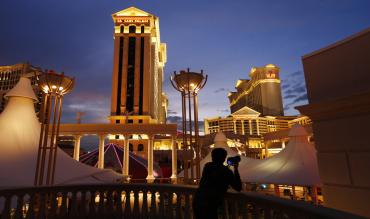Caesars Palace ranks among the great hotel/casinos of Las Vegas. It resonates with a combination of old-school elegance and modern-age conveniences that include a state-of-the-art spa, gorgeous high-roller suites and top dining spots such as the legendary Restaurant Guy Savoy. Bowls of velvety artichoke and black truffle soup rank among the specialties.
Most importantly, Caesars’ gambling is second to none. No less a light than Phil Ivey favors the high-limit room where you can wager $25,000 per hand at baccarat inside a sprawling, chandelier-lit VIP enclave.
The stunning casino dome – complete with a $1 million chandelier of its own – was renovated last year and is impossible to miss as you step onto the 45,000-square-foot gambling floor. Luckily, at the craps table, the first dice toss in the freshly done-up space, courtesy of a Texan gambler named Juan Fresquez, Jr., was a winning seven. The recently installed 15-foot-tall statue of Augustus Caesar greets visitors as they walk in from valet parking.
Superstar chef Guy Fieri, a UNLV alumni, thinks enough of the property that he will be opening his new restaurant there this summer. It will be called Chicken Guy. As he told KTNV in Vegas, “I’m so stoked to be bringing Chicken Guy to Caesars Palace for the best freakin’ chicken tenders, sandwiches and shakes that you’re going to find.”
We’re all in!
Fieri’s joint will have good company with the recently opened Stanton Social Prime (a revival of the old Stanton Social in New York City) and the upcoming Peter Luger Steak House (in my opinion, New York’s top place for prime beef)
And let us not forget the top-notch entertainment. Elton John, Sting, Jerry Seinfeld and Rod Stewart all have deals to perform.
Caesars Palace history
Alluring as Caesars may be right now – with 185 gaming tables, 1,300 machine games and a sports book with giant-sized screens – when it opened in 1966, the place was one of a kind.
At the time of Caesars’ launch, the major gambling dens in Las Vegas were Sands and Desert Inn. They were the reigning high-roller meccas that would soon be eclipsed by Caesars, which was the brainchild of visionary casino boss Jay Sarno.
The Las Vegas Review Journal credits him with “having invented the fantasy resort.” Early on, he got going by building modest hotels that were financed with loans from the allegedly mobbed-up US Teamsters union. By the time of Caesars, Sarno had made lots of money in the hotel business and lost lots to the casinos of Vegas.

Hence, he understood the gambler’s mindset. One important idea he devised with Caesars was that showrooms, pools, restaurants and elevators all radiated off of the casino floor. Only a dyed in the wool gambler would know that guests being forced to walk past gaming tables to get anywhere would not be able to resist making at least a small wager while en route.
“Caesars opened and overnight it stole high-roller thunder from the Sands and the Desert Inn,” I was told by David Schwartz, author of “Grandissimo,” which chronicles the launch of Caesars Palace and conveys the story of Sarno. “The way it was designed, it was the first fantasy architecture in Las Vegas. Everything else in town, at the time, was a little modern and a little tacky. Caesars had fountains, reflecting pools, fantasy, glamor. You drove up the entrance, past the cypress trees, and it felt like you were being transported back in time.”
Sexy waitresses dressed in Roman-style togas; men guarding the entrance had bulging biceps, revealed to great effect from underneath tunics. It was not by accident that Caesars was spelled without an apostrophe. The message conveyed was that we are all Caesars and the Palace belongs to all of us. Cool as it was, Sarno had some ideas that he could not quite pull off.
Most outlandish among them: A giant fish tank, loaded with piranhas, in the center of the Bacchanal dining room. Each night, the unrealized plan went, he would drop a live pig in there for the amusement of his blood-thirsty customers who’d watch the piranhas tear apart the swine.
Sounder minds prevailed on that one, and the pig-eating spectacle never happened.
But Caesars did have Evel Knievel jumping its iconic fountain (the stuntman cleared the fountain but landed badly and broke 40 bones as he tumbled off his motorcycle). Then there were heavyweight boxing matches (Larry Holmes vs. Muhammed Ali among them) that took place in the casino’s outdoor arena. Frank Sinatra, Sammy Davis, Jr. and Aretha Franklin all performed in the big room known as Circus Maximus.
Caesars at the movies
The place is so emblematic of Las Vegas that two Hollywood blockbusters filmed their casino and gambling scenes there. First was “Rainman” with Dustin Hoffman playing the aavant syndrome-suffering Raymond Babbit, who at the coercing of his hard-hustling brother (portrayed by Tom Cruise), counts cards like a human calculator and takes down the house.
In exchange for their prodigious gambling, the pair wind up in the so-called Rain Man suite – actually the Emperor’s suites 6415 and 61416, where you can stay. The suite is a luxe duplex with floor-to-ceiling windows and crystal chandeliers.

“The Hangover” premiered 21 years after “Rain Man” and was filmed at Caesars. But, alas, the guys’ digs – where Mike Tyson’s tiger was stashed and a piano came with the room – was only modeled off of a couple high-roller suites. What you see in the movie was shot on a Hollywood soundstage. However, in a bit of revisionist logic, there is now a “Hangover” suite based on what was created for the movie. It’s popular, of course, with dudes attending bachelor parties.
Old Blue Eyes calls the casino home
Caesars was Frank Sinatra’s spot of choice for lodging, performing and gambling. He moved over from the Sands after having an altercation with Carl Cohen, a casino manager at the Sands. It stemmed from Cohen cutting off Sinatra’s casino credit. Enraged, Sinatra tipped a gambling table onto Cohen. Cohen responded by punching Sinatra in the face, bloodying the singer’s nose and knocking out a pair of front teeth. Sinatra went on a weekend-long tirade and decamped to Caesars, which he patronized for decades.
But even at Caesars, Sinatra didn’t always get his way. He was once displaced from his high roller suite when the drug trafficker Jimmy Chagra, who gambled higher than Sinatra, demanded it. No fisticuffs are said to have ensued.
The casino, known for its sky-high limits has also been favored by advantage players. They include casino-killer Don Johnson and founder of the MIT blackjack team John Chang. Chang convinced the player-development people there that he was the mega-rolling nephew of Chinese computer mogul Dr. An Wang. The player development staff was so impressed by both “Wang’s” lineage and his five-figure bets that they allowed him to win big on 11 occasions before giving him the boot. Though Johnson did not do anything so crafty, he too got 86ed.
But most of us won’t receive such unfriendly treatment. We’ll simply get taken care of like mini Caesars. And that is exactly how Jay Sarno wanted it to be.
*Credits for the cover image belongs to AP Photo/John Locher, File


